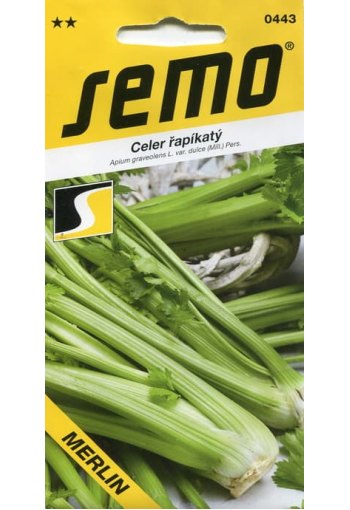Ex Tax: 0.72€
Fresh and crispy stalks.
The methods of cultivation of petiole celery are the same as those of root celery. In warm climates, stalked celery is sown directly in open ground. The seeds are very small (the weight of 1000 seeds is 0.2-0.3 g), and the seeding rate should be reduced accordingly.
Seedlings are planted in furrows: in the open ground for the supply of early production - 10-17, late - 8-11 plants per 1m2. With a high plant density in self-bleaching varieties, it is possible to do without wrapping the petioles with straw or paper. To improve the quality of products, shading is carried out along the edge of the field using a black film. The rate of nitrogen application in the cultivation of petiole celery is not more than 200 kg/ha.
In Central Europe, harvesting in the open field begins in mid-July and ends in early November with the onset of the first frost. The shoots are manually separated from the root collar at the soil level. Leaves can also be shortened. The minimum mass of the marketable part of the crop (a head of petioles) averages 150 g; petiole celery weighing 500 g and even 800 g are in demand on the market. About 90-95% of plants produce marketable products. Yields are about 350 q/ha.
1.0 g = 1800-2500 seeds.
* Stalk celery is very useful for people suffering from high blood pressure, as it is able to normalize it due to the high content of calcium. In addition, fresh juice is considered an excellent blood cleanser. Due to its high sodium content, it has a salty taste, so it can be added to dishes instead of table salt.
Grow stalk celery through seedlings in the same way as root. Yes, and caring for him is simple: watering and 2-3 times feeding with complex organo-mineral fertilizer (better - liquid).
Celery is sensitive to a lack of sodium in the soil, so at the age of 30-40 days, you can feed it with a solution of table salt at the rate of 2-3 g / m2.
There is only one important nuance, ignorance of which can lead to disappointment in this vegetable: 2-3 weeks before harvesting, the petioles must be "bleached".
Thanks to this agricultural technique, the green colour is lost, the content of essential oils is reduced, and, therefore, bitterness also goes away, which allows the petioles to become juicy, tender and crispy.
European vegetable growers practice the method of planting seedlings in a groove: when the plants reach 30 cm, side shoots are removed from the celery, the petioles are wrapped with corrugated cardboard, not very tightly tied with twine and the groove is covered with soil. Before harvesting, the plants are once again highly planted with soil, which should not fall into the outlet.
To whiten the petioles of celery, once every three weeks, it is necessary to highly hill (in dry weather, so that the petioles do not rot), and then completely wrap the leaf socket in thick paper. The easiest way is to pack the petioles in opaque plastic bottles or other opaque packages with an approximate volume of about 1 litre: we cut them off on both sides, and on the resulting cylinder we make a longitudinal cut, which makes it possible to wrap it around the stems. From below, we add earth to it so that there are no cracks. From afar, it seems that someone has placed vases with celery leaves in the garden...
There are varieties of celery that do not require bleaching (Celebrity, American Green), but finding their seeds is difficult. In addition, they are less resistant to cold.
Stem celery is harvested selectively: from mid-August to late autumn. Bleached petioles are cut off at the base, and cleaned from the ground, damaged leaves are removed and carefully placed in boxes.
Eng.: Celery-stalk. Suom.: Ruotiselleri. Sven.: Blekselleri. Bot.: Apium graveolens var. dulce











